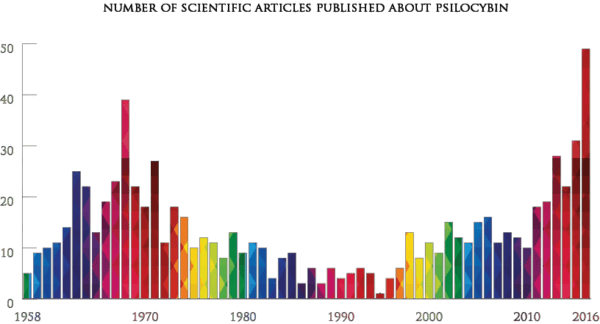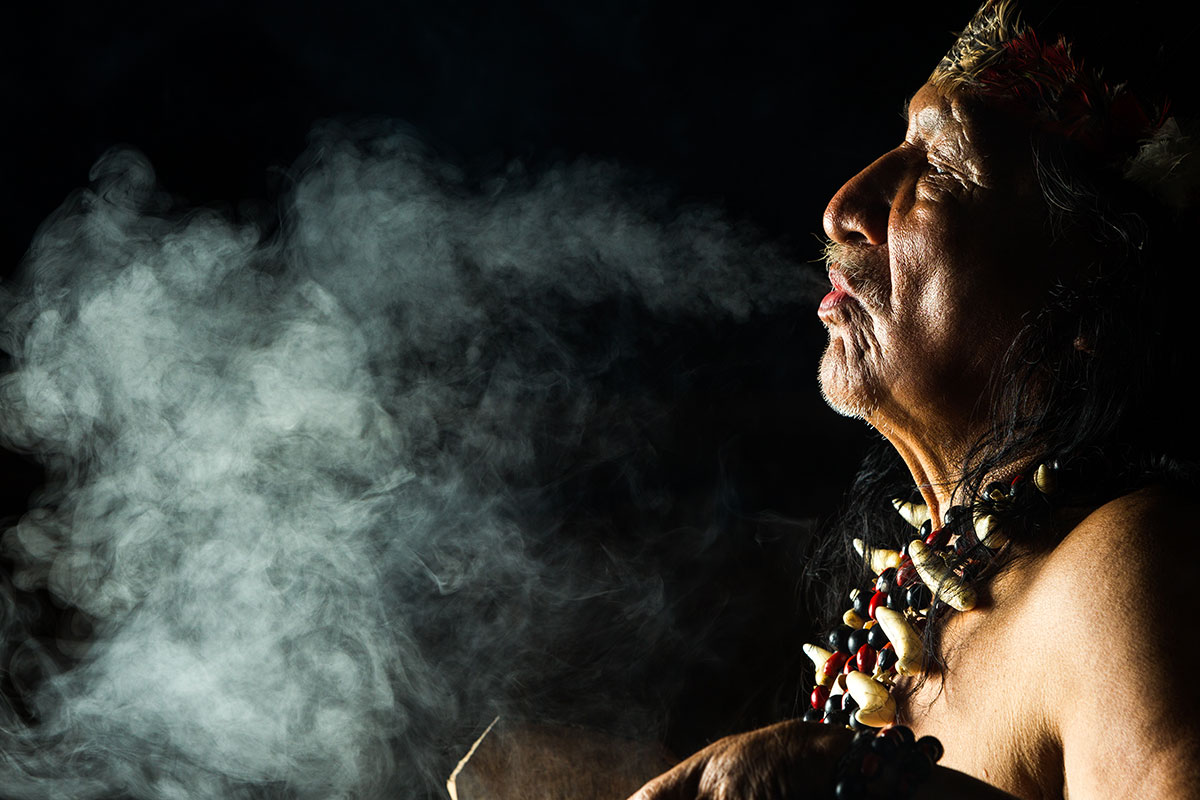Psychedelic substances have been a part of human culture for thousands of years. The word “psychedelic” comes from two Greek words: psyche (soul) and delos (clear). Psychedelic substances are hallucinogenic drugs that can change and enhance sensory experiences, thought processes, and energy levels. They’ve even been used to facilitate spiritual experiences.
Psychedelic Use by Indigenous Peoples
Before we can begin to understand the modern history of psychedelic drugs in the United States, we must go back further into history and look at the use of psychedelics by indigenous cultures who lived there—long before colonial Americans or Europeans discovered them. These mind-altering substances arguably catalyzed evolving stages of human culture and consciousness. Growing research shows psychedelics are incredible in their potential to heal a panacea of human ailments and conditions.
Perhaps even more astounding are the centuries-old traditions showing humans have used these substances to shape their destinies. Although our research is limited by the lack of written accounts, some anthropologists believe prehistoric people may have consumed psychedelic plant species as long ago as 10,000 BCE.
Central and South American Cultures
Central and Southern American cultures have a long history with psychedelics. The Mayan and Aztec people have used psilocybin-containing mushrooms (often called magic mushrooms today), peyote, and other psychedelic drugs for healing purposes during spiritual rituals. These and other ancient cultures built temples to mushroom gods. In fact, evidence of rituals, ceremonies, and celebrations using psilocybin mushrooms dating back to 3,000 BCE have been found in various regions of Mesoamerica. Psychedelic mushrooms are depicted in many forms of Mesoamerican art and sculpture, suggesting that they were collected and consumed by priests for their visionary properties.
Peyote, a small cactus that originates from Mexico and the Southern United States, is a plant that has been used for its hallucinogenic properties by Native Americans for thousands of years. The Huichol of Mexico traditionally consumed it in small amounts as part of their spiritual rituals. Records indicate that indigenous groups began practicing the use of peyote as part of worship ceremonies during the early 20th century when they were relocated from their original homelands following European settlement around 1800 AD. During this time the Native American Church (NAC) was formed and peyote was used as part of a religious sacrament during prayer ceremonies.
Ayahuasca, another psychedelic substance, is a plant that has been used for centuries by people from many different countries and is still widely consumed today. It’s often ingested as an entheogenic brew, but it can also be applied topically to the skin or taken internally in liquid form. In the Quechua language, the word “ayahuasca” translates to “vine of souls”. This ancient mix has been used by tribes in the Amazon basin for centuries and boasts both medicinal and spiritual purposes. Ayahuasca can produce profound effects when consumed under ceremonial conditions.
Psychedelic Research in Modern History
In the early 20th century, many people who were interested in psychedelics and their effects on human consciousness experimented with them. The first modern psychedelic research can be attributed to Swiss chemist Albert Hofmann, who synthesized LSD in 1938. Its effects, however, were not discovered until April 19th, 1943 when Hofmann accidentally ingested some of the substance and experienced intense hallucinations. April 19th is now known as “Bicycle Day”. Bicycle Day is not a celebration of bicycles but instead honors Albert Hofmann, because he discovered the psychedelic effects of LSD while riding home from his lab on that day in 1943. Hofmann then devoted the rest of his life to studying psychedelics, including LSD, DMT (Nexus), and psilocybin mushrooms (magic mushrooms).
Psychedelic drug research continued in the United States and other countries through the 1950s and 1960s by scientists and psychotherapists looking for therapeutic and medicinal benefits of the substances.
In 1951 a psychiatrist named Humphrey Osmond took a job as deputy director of psychiatry at the Weyburn Mental Hospital in Saskatchewan, Canada. For 12 months he collaborated on experiments using LSD before trying it out himself to conclude that this drug could produce profound changes in consciousness. He then recruited volunteers who had taken LSD for their own research, theorizing that this substance was capable of inducing new levels of self-awareness which may have enormous therapeutic potential. In 1953, Osmond and his partner gave LSD to patients struggling with alcoholism. By the end of the 1960s, Osmond had treated over 2,000 patients with a single, large dose of LSD. His research showed that between 40-45% of patients who had taken the drug did not experience a relapse, even after one year.
Throughout the 1950s and 1960s—during the height of the Cold War—the CIA conducted a top-secret project called MK-Ultra, in which the government administered LSD and other drugs on unwitting citizens as an experiment in mind control. The goal of this project was to develop mind-control techniques that could be used on Soviet enemies.
American Counterculture
The 1960s saw a dramatic shift in attitudes towards psychedelics. LSD, for example, was popularized during this time by figures like Timothy Leary and Ken Keseys. It became a symbol of rebellion, with many people using it to protest against authority or for recreational use. LSD became associated with anti-war protests, student activism, and free love.
In 1966, the U.S. Congress passed the Drug Abuse Control Amendment, which banned the sale or manufacturing of LSD and other hallucinogens for anything other than testing by doctors or pharmacologists who needed to determine if they should be approved for more widespread medical use. At this time, only the manufacturing of LSD was illegal; personal possession and use of LSD were not punishable by law.
Restrictions became even tighter when The Controlled Substances Act was passed by Congress and signed into law on October 27th, 1970. The CSA placed all psychedelics under Schedule I classification, which means that they are considered to have a high potential for abuse with no accepted medical use. The passage of the CSA launched President Nixon’s War on Drugs, a series of laws and policies passed by the United States government in order to discourage recreational drug use. The legislation included stricter penalties for possession of these now illegal substances, as well as mandatory sentencing guidelines. The Controlled Substances Act effectively put a halt to much of the research that was being conducted on psychedelic drugs.
This graph from the Beckley Foundation shows a large number of scientific articles about psilocybin (another psychedelic drug that was outlawed with the passage of the Controlled Substances Act) published in the 1960s and 70s, and then a strong dropoff right around the time of the passage of the CSA.

The “Psychedelic Renaissance”
A 2010 study indicated that there are over 30 million people in the United States who currently identify as users of psychedelics. Today, more and more researchers are turning to psychedelics for the possibility of treating depression, anxiety, alcoholism, and other substance use disorders.
In 2017, the psychedelic drug MDMA (also known recreationally as ecstasy) was given “breakthrough” designation by the FDA and is currently being studied as an adjunct therapy treatment for various mental health disorders. Although it is not yet officially approved for use, there have already been promising results in clinical studies.
LSD continues to be an important tool in scientific research. A recent study analyzed 11 randomized-controlled clinical trials on the therapeutic use of LSD in psychiatry, and positive results were observed that indicate that LSD could be used as a potential therapeutic agent in psychiatry, particularly for the treatment of alcoholism.
Additionally, research is currently being conducted on the use of psilocybin (magic mushrooms) for the treatment of Major Depressive Disorder (MDD), addiction, and other mental health conditions. Johns Hopkins Medicine researchers are currently studying the effects of psilocybin on cancer patients with Major Depressive Disorder. Their research suggests that psilocybin may be more effective than traditional antidepressant drugs.
While much more research needs to be done on the use of psychedelic drugs for medicinal and therapeutic purposes, the increase in attention that these substances are seeing during this “Psychedelic Renaissance” is an exciting indicator of what breakthroughs may be in the near future for psychedelics and psychedelic-assisted therapy. Though regulation of psychedelics by the federal government has made approval for these therapies a rigorous and complex process, there is reason to believe that some psychedelics will be available for prescription in the near future thanks to groundbreaking research efforts.









